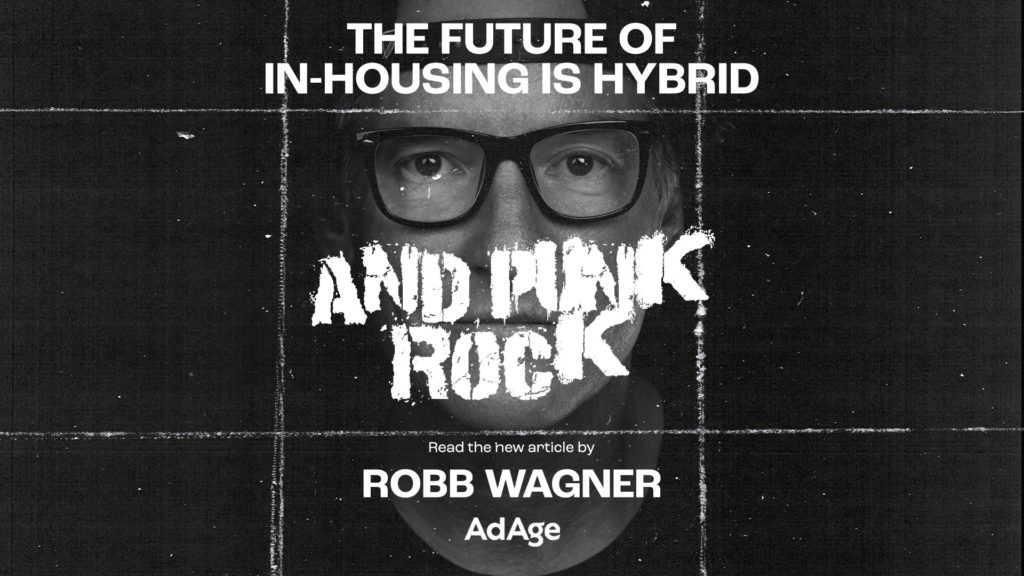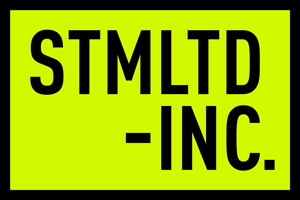
By Robb Wagner
Republished from Ad Age

Microsoft’s Geoffrey Colon shared a recent post on LinkedIn that made me smile. “The punk rock era of creative work is here. And of course the people who hate it are the corporate rock types.”
I spent the late 1990s working in major broadcast entertainment by day and playing guitar in the Silverlake (Los Angeles) music scene by night. All of Silverlake was a stage and everyone within it was a musician. We didn’t have to drive far or spend a lot of money. Our music movement was formed around wild creativity that came from within our community.
What does this have to do with in-housing and hybrid creative work? A lot.
When all the world’s a stage and every brand is now a storyteller, the result is a perfect storm for in-housing, as companies balance the growing demand for digital marketing assets and need to cut outside agency costs with an increasing desire for creativity that comes from within their own internal culture.
It’s why conglomerates like Coca-Cola, Red Bull and Kind built content studios driving their creative processes, while others like Liberty Mutual and Clorox built in-house media teams to tighten the dynamic between creative, media planning and agency execution. And with new examples popping up almost daily, in-housing has certainly reached peak trend designation.
The allure is understandable.
Companies leaning into in-housing believe that an in-house team is already tuned into their needs with a unique familiarity that can help them more easily determine which approaches work best — whether it’s the most fitting topics to write about, the best keywords to use, or the most accurate ways to portray their target groups.
“An in-house marketing team is embedded in the company and has a deep understanding of brand, culture, product and internal processes,” explained Zoe Matthews, Marketing manager at Dealer Auction, in a blog interview for Filestage.
In-housers will also tell you that while an outside agency can be briefed on your company’s goals and campaigns, there’s still no replacing the home team’s connection to company philosophy.
And because the in-house team knows and works exclusively with the company, it stands to reason that they’ll tend to put much more dedication into their work. In other words, the company’s fortune is also their fortune. This dedication and interest in the work can be thought of as extra motivators from which everyone will reap the benefits.
Furthermore, conventional wisdom says when you work daily as a team to achieve your goals, there’s a camaraderie that makes marketing discussions much easier because everyone is engaged and wanting to move forward. Thinking intuitively, this should also mean a faster path to communication because you’re all in the same place, as opposed to looping in outside agencies, which often requires scheduling meetings with multiple people at once.
Win, win, win, right? Not so fast. What people are not thinking or talking about enough is what happens when those in-house agencies become overloaded with creative work and must turn to outsourcing as a makeshift solution – a move that puts them right back into the agency model they’ve been trying to get away from, and paying a premium in the process.
The fact is, 90 percent of in-house agencies already report that they still work with external agencies. And, behind the scenes, the industry acknowledges that in-housing comes with its own set of new problems to solve. For example, managing workflow has been identified as the key barrier to success for in-house agencies.
Another problem facing in-house teams is a demand for content that is increasing exponentially with the continued proliferation of distribution channels. And as the Metaverse (defined by Bloomberg as a virtual world that blends aspects of digital technologies including video-conferencing, games like Minecraft or Roblox, cryptocurrencies, email, virtual reality, social media and live-streaming) looms ever nearer, the need for digital assets is likely to grow at an alarming rate. When we arrive at the doorstep of the Metaverse, for example, will in-house agencies have all of the Unreal Engine developers they need in-house? If not, will they be forced to hire external companies, which is exactly what they are trying to avoid? Or, will they have to hire and try to manage freelancers, which is inefficient, costly and exhausting at scale?
And still another potential downfall is the risk that in-house teams will fall behind the shifting demands of the market. For instance, how would an in-house team pivot to develop an experiential retail initiative if they didn’t have experience creating experiential media content? If the core team was only skilled in developing ordinary advertising content (i.e., print or Facebook ads), would it have the talent necessary to develop, design and execute on the required level of immersivity and interactivity? If not, are they again outsourcing at a premium, and burning out their in-house team trying to manage it all?
Today, if an in-house team gets overwhelmed (too much work), their go-to options are:
- Hiring an external company to embed additional people into their in-house agency, which costs a premium.
- Trying to hire and manage freelancers, which is exhausting.
- Hiring an outside creative agency to do the work for them, which negates the benefits of doing in-house work.
Even if the in-house agency does all of these things, there is still a likelihood that they will be overwhelmed, overworked and exhausted managing all of these moving parts. That’s just the nature of project management at the scale of a global company.
How can they avoid such pitfalls? That answer, in my opinion, requires both unconventional wisdom and counterintuitive thinking. This is where the punk rock piece comes in. Hear me out.
When I teach my hybrid work method to creative agencies, I start off each session by telling my class that if they’re not open to fundamental mindset shifts or counterintuitive thinking, they should leave, because it’s not going to work. That’s a hard truth, but it is a truth.
One of the more radical concepts in my upcoming book, “The Stimulated Method,” for example, tells readers to “stop assigning work to artists.” I teach creatives that if you let your workforce choose the jobs they want to work on, you’ll get better work.
People embracing the ‘punk rock’ mindset get it right away. Another radical concept that challenges traditional agency instincts is reducing project management or eliminating it altogether. Wait… what??? Exactly. And yet this punk rock mindset shift is clutch in how I deliver — with no project managers — seven-figure projects.
Below are seven more examples (from my book) of the counterintuitive mindset shifts needed to master hybrid creative work at scale.
- Don’t fall for shiny portfolios. By far, the most important attribute of a remote artist is their ability to follow written instructions. Your most important job when vetting your remote creative workforce is weeding out artists that cannot follow written instructions. If you don’t, you are likely to receive deliverables that can jeopardize your project.
- Flip the emphasis to preparation. With fully in-house creative work, approving the brief typically means all of the hard work is about to begin. On the other hand, when hybrid creative work is done right, just the opposite is true. Once you’ve written the brief, the hardest part will be behind you and you will find yourself on Easy Street.)
- The time to be wildly creative is at the beginning of the project, not in the middle or at the end. In-house creative directors and producers often get comfortable being reactive. With hybrid creative work, they must be proactive. This doctrine is essential.
- Place absolute importance on the job brief. For a remote artist, the job brief is the de facto substitute for you. It is the creative director, producer, coordinator and project manager all at the same time. Therefore, it must be able to answer every creative, technical, and logistical question an artist may have in the exact moment when it is needed.
- Rethink your creative studio as an assembly line. When you envision an assembly line like Tesla’s, it is easy to understand the need for robust automated workflows to make the process work. At the scale of a global company, hybrid creative work requires heavy equipment, which is where an automation solution comes into play. Without having an automated ‘factory’ to build the cars or — in our world — the assets, hybrid creative work at scale is impossible.
- Always communicate with empathy. Our job is to make remote artists feel like they are part of the team, even when they are home alone — to let them know that we care about them and have the utmost respect for their time, their livelihood and the work that they do. By writing every word a remote artist might read with empathy, you will get their best work.
- Let go of trying to manage artists’ time. You can’t expect artists in different time zones to be available when you decide you need them. Traditional thinkers might see this as a limitation. However, at scale, the opposite is true. When you consider that 10, 20, 30 or more remote artists can be added to a project at any given moment, you must realize that remote creative work can offer exponential speed-to-market versus traditional, in-house creative work.
If your mind is open to these unconventional ideas, you’re on the right track. To sum it up, in the punk rock era of creative work, you can’t be a corporate rock type. You have to be willing to jump into the mosh pit.
God save the queen, and live your best creative work-life.
Republished from Ad Age
https://adage.com/article/opinion/future-housing-hybrid-and-punk-rock/2384536
